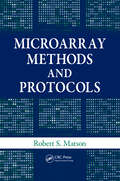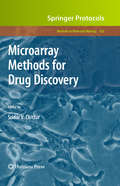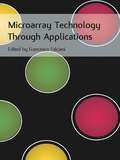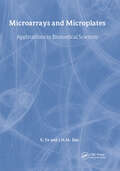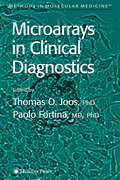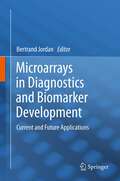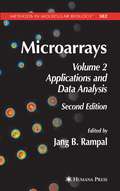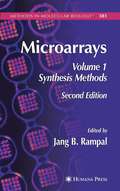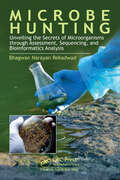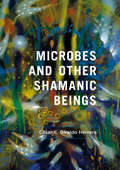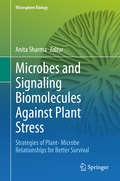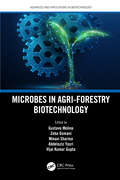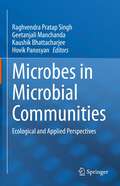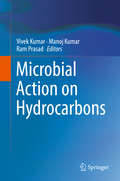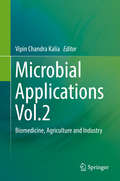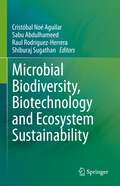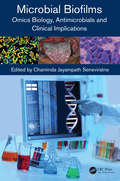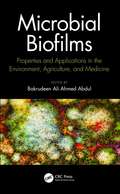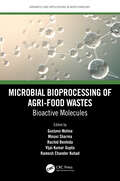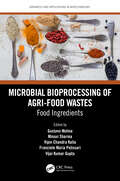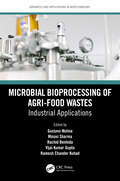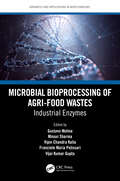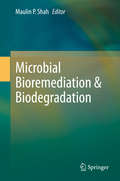- Table View
- List View
Microarray Methods and Protocols
by Robert S. MatsonA Step-by-Step Guide to Present and Future Uses of Microarray TechnologyMicroarray technology continues to evolve, taking on a variety of forms. From the spotting of cDNA and the in situ synthesis of oligonucleotide arrays now come microarrays comprising proteins, carbohydrates, drugs, tissues, and cells. With contributions from microarray experts
Microarray Methods for Drug Discovery
by Sridar V. ChitturWhile the utilization of microarrays for gene expression studies has been widely published, Microarray Methods for Drug Discovery describes the use of this technology for a multitude of other vital applications. Covering the field of drug discovery through its various aspects, including high throughput screening, target identification, drug metabolism and toxicity screening as well as clinical sample handling, this volume also addresses new emerging fields like miRNA profiling, ribonomic and glycomic profiling. All chapters, contributed by experts in the field, follow the highly successful Methods in Molecular BiologyTM series format, which is comprised of brief introductions, lists of required materials and reagents, readily reproducible, step-by-step lab protocols, along with detailed tips on troubleshooting and avoiding known pitfalls, making this book an easy read for investigators at all levels of expertise. Authoritative and cutting-edge, Microarray Methods for Drug Discovery provides an ideal desk reference for scientists who wish to use microarray technology in order to better understand a variety of biological interactions in their respective fields.
Microarray Technology Through Applications
by Francesco FalcianiMicroarray Technology Through Applications provides the reader with an understanding, from an applications perspective, of the diverse range of concepts required to master the experimental and data analysis aspects of microarray technology. The first chapter is a concise introduction to the technology and provides the theoretical background required to understand the subsequent sections. The following chapters are a series of case studies representative of the most general and important applications of microarray technology, including CGH, analysis of gene expression, SNP arrays and protein arrays. The case studies are written by experts in the field and describe prototypic projects, indicating how to generalize the approach to similar studies. There are detailed step-by-step protocols describing the specific experimental and data analysis protocols mentioned in the case study section. There is also information on printing glass DNA microarray slides and data interpretation. Colour figures and data sets are provided on the website at http://www.garlandscience.com/9780415378536
Microarrays and Microplates: Applications in Biomedical Sciences (Advanced Methods Ser.)
by S. Ye I.N.M. DayThe 'Advanced Methods' series is intended for advanced undergraduates, postgraduates and established research scientists. Titles in the series are designed to cover current important areas of research in life sciences, and include both theoretical background and detailed protocols. The aim is to give researchers sufficient theory, supported by references, to take the given protocols and adapt them to their particular experimental systems.Microarrays and Microplates title looks at the new microarray and microplate-based technologies which facilitate large-scale analysis of DNA sequence variants, mRNA molecules and proteins. The book provides a review of the various methodologies being used to identify genetic variants and gene regulation and guides readers through both the application of these methodologies and experimental procedures.
Microarrays in Clinical Diagnostics
by Thomas O. Joos Paolo FortinaLeading academic and industrial investigators surveys the world of microarray technology, describing in step-by-step detail diverse DNA and protein assays in clinical laboratories using state-of-the-art technologies. The advanced tools and methods described are designed for mRNA expression analysis, SNP analysis, identification, and quantification of proteins, and for studies of protein-protein interactions. The protocols follow the successful Methods in Molecular BiologyTM series format, each offering step-by-step laboratory instructions, an introduction outlining the principle behind the technique, lists of the necessary equipment and reagents, and tips on troubleshooting and avoiding known pitfalls.
Microarrays in Diagnostics and Biomarker Development
by Bertrand JordanMicroarray technology has made strong progress over the past decade, and there have also been significant changes in application areas, from nucleic acids to proteomics and from research to clinical applications. This book provides a comprehensive overview of microarrays in diagnostics and biomarker development, covering DNA, peptide, protein and tissue arrays. The focus is on entities that are in actual clinical use, or quite close, and on recent developments, such as peptide and aptamer arrays. A further topic is the miniaturisation towards "nanoarrays", which is expected to have great potential in clinical applications. Relevant issues of bioinformatics and statistical analysis of array data are discussed in detail, as well as the barriers to the commercialisation of array-based tests and the vexing IP issues involved. Thus, the book should be very useful tor active array users as well as to newcomers seeking to make the best choice between different technologies.
Microarrays in Diagnostics and Biomarker Development: Current and Future Applications
by Bertrand JordanMicroarray technology has made strong progress over the past decade, and there have also been significant changes in application areas, from nucleic acids to proteomics and from research to clinical applications. This book provides a comprehensive overview of microarrays in diagnostics and biomarker development, covering DNA, peptide, protein and tissue arrays. The focus is on entities that are in actual clinical use, or quite close, and on recent developments, such as peptide and aptamer arrays. A further topic is the miniaturisation towards “nanoarrays”, which is expected to have great potential in clinical applications. Relevant issues of bioinformatics and statistical analysis of array data are discussed in detail, as well as the barriers to the commercialisation of array-based tests and the vexing IP issues involved. Thus, the book should be very useful tor active array users as well as to newcomers seeking to make the best choice between different technologies.
Microarrays, Volume 2, Applications and Data Analysis
by Jang B. RampalMicroarray Technology, Volumes 1 and 2, present information in designing and fabricating arrays and binding studies with biological analytes. This is done while providing the reader with a broad description of microarray technology tools and their potential applications. The first volume deals with methods and protocols for the preparation of microarrays. The second volume details applications and data analysis, which is important in analyzing the enormous data coming out of microarray experiments. <P><P>Microarray Technology, Volumes 1 and 2, provide ample information to all levels of scientists from novice to those intimately familiar with array technology.
Microarrays, Volume I: Synthesis Methods
by Jang B. RampalMicroarray Technology, Volumes 1 and 2, present information in designing and fabricating arrays and binding studies with biological analytes. This is done while providing the reader with a broad description of microarray technology tools and their potential applications. The first volume deals with methods and protocols for the preparation of microarrays. The second volume details applications and data analysis, which is important in analyzing the enormous data coming out of microarray experiments. <P><P>Microarray Technology, Volumes 1 and 2, provide ample information to all levels of scientists from novice to those intimately familiar with array technology.
Microbe Hunting: Unveiling the Secrets of Microorganisms through Assessment, Sequencing, and Bioinformatics Analysis
by Bhagwan Narayan Rekadwad"Microbe Hunting: Unveiling the Secrets of Microorganisms through Assessment, Sequencing, and Bioinformatics Analysis" embarks on a captivating expedition into the unseen world of microorganisms. This insightful journey navigates the intricate realms of microbial diversity, unwrapping the significance of ecological roles and technological advancements. Through the lens of assessment techniques, the book unveils the art of sample preparation and the transformative power of sequencing technologies, shedding light on the uncharted territories of bioinformatics analysis. From decoding taxonomic landscapes to unearthing functional treasures, this book traverses metagenomics and its benefits for human. With ethical considerations and glimpses into the future, the voyage culminates, offering a profound understanding of the microbial universe and its boundless potential.
Microbes and Oral Squamous Cell Carcinoma: A Network Spanning Infection and Inflammation
by Samapika RoutrayThis book helps in understanding the relationship between microorganisms and oral carcinogenesis, and the possible oncogenic mechanisms enhancing the association. The book highlights the association between oral cancer, primarily oral squamous cell carcinoma (OSCC), a major global health problem with high incidence and low survival rates with infection and inflammation. Establishing the association of the oral microbiome with cancer risk may lead to significant advances in the understanding cancer etiology, potentially opening a new research paradigm for cancer prevention.The book takes the readers through interesting topics such as the epidemiology and etiology of OSCC, the hallmarks of cancer, and the role of inflammation in OCSS. It presents the difference between the normal and diseased oral microbiome. It further describes the carcino-pathogenesis of various groups. Finally, it discusses the clinical correlation of the observations and what the future looks like for this area of research.The book is interesting for medical students, researchers and clinicians, alike. The knowledge from the book can be exploited practically and used for designing further experiments.
Microbes and Other Shamanic Beings
by César E. Giraldo HerreraShamanism is commonly understood through reference to spirits and souls. However, these terms were introduced by Christian missionaries as part of the colonial effort of conversion. So, rather than trying to comprehend shamanism through medieval European concepts, this book examines it through ideas that started developing in the West after encountering Amerindian shamans. Microbes and Other Shamanic Beings develops three major arguments: First, since their earliest accounts Amerindian shamanic notions have had more in common with current microbial ecology than with Christian religious beliefs. Second, the human senses allow the unaided perception of the microbial world; for example, entoptic vision allows one to see microscopic objects flowing through the retina and shamans employ techniques that enhance precisely these kinds of perception. Lastly, the theory that some diseases are produced by living agents acquired through contagion was proposed right after Contact in relation to syphilis, an important subject of pre-Contact Amerindian medicine and mythology, which was treasured and translated by European physicians. Despite these early translations, the West took four centuries to rediscover germs and bring microbiology into mainstream science. Giraldo Herrera reclaims this knowledge and lays the fundaments for an ethnomicrobiology. It will appeal to anyone curious about shamanism and willing to take it seriously and to those enquiring about the microbiome, our relations with microbes and the long history behind them.
Microbes and Signaling Biomolecules Against Plant Stress: Strategies of Plant- Microbe Relationships for Better Survival (Rhizosphere Biology)
by Anita SharmaThis book sheds new light on ways to alleviate biotic and abiotic stress in plants, using signaling molecules of plant growth promotory rhizobacteria. Further, it elaborates on the different types of stress and strategies used by plants under various stress conditions. The respective sections describe the importance of the microbiome for the overall health of plants and how exploring plant-microbe communication and signaling pathways could offer a promising avenue for future research. The book also discusses how rhizobacteria could be exploited in stress alleviation and sustainable agriculture, and addresses omics strategies for stress response and mitigation. Thanks to clearly annotated references, the book also supports and encourages readers to further explore the topics discussed.
Microbes in Agri-Forestry Biotechnology (Advances and Applications in Biotechnology)
by Vijai Kumar Gupta Gustavo Molina Minaxi Sharma Zeba Usmani Abdelaziz YasriThis book explores recent advances on the use of microbes for agri-forestry biotechnological applications. It provides technical concepts and discussions on the use of microorganisms for processes such as bioprocessing, bioremediation, soil enhancement, aquaponics advances, and plant-host symbiosis. The book provides an overview of the microbial approach to the tools and processes used in agriculture and forestry that make or modify products, improve plants for specific uses, and make use of livestock in agricultural systems. The authors discuss the main process conditions that enhance agri-forestry applications with the use of microbes and introduce the use of genetically modified (GM) microbes in agrobiotechnology. Finally, the authors explore the main technological advances in the production of secondary metabolites with potential applications in agri-forestry. This book is intended for biotechnologists, biologists, bioengineers, biochemists, microbiologists, food technologists, enzymologists, and related researchers.
Microbes in Microbial Communities: Ecological and Applied Perspectives
by Hovik Panosyan Raghvendra Pratap Singh Geetanjali Manchanda Kaushik BhattacharjeeThe book overviews the complex interactions amongst the microbes and their possible applications. Emphasis has been made to include a wide spectrum of experimental and theoretical contributions from eminent researchers in the field. Microbial communities are the assemblages of microorganisms of various species which live together in the same environment and continuously interact with each other. The microbial cells in communities display unique phenotypes that affect the survival and reproduction of other cells present around them. These phenotypes constitute the social adaptations that drive the interactions between microbial cells. The interactions, further determine the productivity, stability and the ability of community to resist the environmental perturbations. These microbial communities live with extremely competitive niche and fight for their survival and genetic persistence. But they frequently appear in niche with multifaceted and interactive webs rather than the planktonic nature. This can be within the same species or with different species, or even with diverse genera and families. It either a competitive winner community whereas the “weaker” strain goes extinct or a competitor that coexist with their metabolic secretory potentials or a separator that assigned their own community territorial niches. Sometimes, it can be neutral or tritagonist. These microbial associations within the microbiome provides the foundation for diverse forms of microbial ecology and determined the applied perspectives for agriculture, clinical and industrial sectors. This book will be useful to postgraduate students, researchers from academic as well as industry working in the field of microbial exploration with keen interest in survival factors and mechanism of their survival by various ecological and functional strategies.
Microbial Action on Hydrocarbons
by Manoj Kumar Ram Prasad Vivek KumarThe book discusses ways to overcome the side effects of using hydrocarbon-based products as energy sources. Hydrocarbons produce raw crude oil waste of around 600,000 metric tons per annum, with a range of uncertainty of 200,000 metric tons per year. The various chapters in this book focus on approaches to reduce these wastes through the application of potential microbes, in a process called bioremediation. The book is a one-stop reference resource on the methods, mechanisms and application of the bio-composites, in the laboratory and field. Focusing on resolving a very pressing environmental issue, it not only provides details of existing challenges, but also offers deeper insights into the possibility of solving problems using hydrocarbon bioremediation.
Microbial Applications Vol.2
by Vipin Chandra KaliaThis contributed volume provides insights into multiple applications using microbes to promote productivity in agriculture, to produce biochemicals or to respond to challenges in biomedicine. It highlights the microbial production of nanocompounds with medical functionality alongside new anti-mycobacterial strategies, and introduces plant-growth-promoting Rhizobacteria as well as the correlation between biofilm formation and crop productivity. Further, the authors illustrate the green synthesis of biochemical compounds, such as hydroxamid acid or biosurfactants, using microbial and fungal enzymes. It inspires young researchers and experienced scientists in the field of microbiology to explore the combined use of green, white and red biotechnology for industrial purposes, which will be one of the central topics for future generations.
Microbial Biodiversity, Biotechnology and Ecosystem Sustainability
by Sabu Abdulhameed Shiburaj Sugathan Cristóbal Noé Aguilar Raul Rodriguez-HerreraThis book gives insight into several aspects of the microbiology, biotechnology, and ecosystem sustainability of special and under-explored regions, that captivate human beings by their natural richness, their extensive biodiversity, the extraordinary forms of adaptation of the living beings that they inhabit, and even that keep living secrets as is the very origin of life. The chapters emphasize all aspects of biological diversity-its description, analysis, and conservation, and its controlled rational use by humankind. Also, the book is elaborated from a wide and multidisciplinary point of view. It presents reviews, research papers, comments, and research notes on biodiversity, ethnobiology, geoscience, chemistry, biological conservation, biotechnology, and ecosystem sustainability Two hotspots are the reference for this enriching book that describes details of extraordinary areas of the planet, from Cuatrociénegas, Coahuila (Mexico) to the Southern Western Ghats (India). The book will contribute to dealing with the practicalities of conservation management, economic, social, and political issues. It provides a forum for examining conflicts between sustainable development and human dependence on biodiversity in agriculture, environmental management, and biotechnology, and encourages contributions from developing countries to promote broad global perspectives on matters of biodiversity and conservation.
Microbial Biofilms: Omics Biology, Antimicrobials and Clinical Implications
by Chaminda Jayampath SeneviratneMicrobial Biofilms: Omics Biology, Antimicrobials and Clinical Implications is a comprehensive survey of microbial biofilms and their role in human health and disease with contributions from world renowned experts in molecular microbiology, proteomics, genomics, metabolomics and infectious diseases. The book is intended to serve as a guide for students, as well as a reference for researchers, clinicians and industry professionals. <P><P>The chapters cover bacterial and fungal microbiomes, and the latest omics techniques organized in a clear and up-to-date manner. One of the highlights of this book is the comprehensive information on "omics of microbial biofilms". The chapters dedicated to metagenomics, proteomics and metabolomics are designed to provide a simple and holistic review of the current knowledge and, the applications of these techniques in the field of microbial biofilms. In addition to introductory chapters on microbial biofilms and their clinical implications, subsequent chapters delve into oral biofilms, their composition, and metagenomic diversity. Thereafter, mechanisms of drug resistance in microbial biofilms are reviewed, as well as the proteomic and metabolomic characterization of this resistance. The book includes a comprehensive discussion of persister cells and host–microbial interactions on mucosal surfaces. Finally, the book concludes with a summary of novel therapeutic approaches for biofilms such as synbiotics and biogenics.
Microbial Biofilms: Properties and Applications in the Environment, Agriculture, and Medicine
by Bakrudeen Ali Ahmed AbdulThis book provides a broad range of applications and recent advances in the search for biofilm materials in nature. It also explains the future implications for biofilms in the areas of advanced molecular genetics, pharmaceuticals, pharmacology, and toxicology. This book is comprised of 20 chapters from leading experts in the field and it examines immunology and microbiological studies derived from biofilms as well as explores environmental, agricultural, and chemical impacts on biofilms. It is divided into five subdivisions: biofilms and its complications, biofilm infections in human body, detection of biofilm-forming pathogens, antibiofilm chemotherapy, and biofilms production tools in aquaculture. This book may be used as a text or reference for everyone interested in microbial biofilms and their current applications. It is also highly recommended for environmental microbiologists, medical microbiologists, bioremediation experts, and microbiologists working in biocorrosion, biofouling, biodegradation, water microbiology, quorum sensing, and many other related areas. Scientists in academia, research laboratories, and industry will also find it of interest. This book includes chapter homework problems and case studies. Powerpoints are also available for adopting instructors. Discusses and clarifies the resource of isolation and chemical properties from biofilms Discusses the latest pharmaceutical, pharmacological, and medicinal approaches toward the treatment of chronic and uncured diseases, such as Alzheimer’s osteoporotic, sexual dysfunction, sleep sickness, allergy treatment, asthma, hair loss, AIDS, hypertension, antiaging, etc. Examines immunology and microbiological studies derived from biofilms Explores environmental, agricultural, and chemical impacts on biofilms. Dr. Bakrudeen Ali Ahmed Abdul is an Associate Professor, the Head of the Department of Biochemistry and Dean of the School of Life Sciences, Centre for Research and Development (CRD), PRIST Deemed University, Vallam, Thanjavur, Tamil Nadu, India. His research areas include the application of plant biochemistry, bioactive compound production, biotechnological methods, development of pharmaceutical products and pharmacological studies.
Microbial Bioprocessing of Agri-food Wastes: Bioactive Molecules (Advances and Applications in Biotechnology)
by Vijai Kumar Gupta Gustavo Molina Ramesh Chander Kuhad Minaxi Sharma Rachid BenhidaThis book gives a comprehensive overview of recent advances in the valorization of agri-food waste and discusses the main process conditions needed to overcome the difficulties of using waste as alternative raw materials. It also discusses specific methodologies, opportunistic microbes for biomass valorization, the sustainable production of agri-food waste, as well as examines the assessment and management of bioactive molecules production from microbial-valorization of agri-food waste. The authors provide technical concepts on the production of various bio-products and their commercial interest including agri-food waste utilization in the microbial synthesis of proteins, the valorization of horticulture waste, the sustainable production of pectin via microbial fermentation, as well as other food and pharmacological applications. This book is intended for bioengineers, biologists, biochemists, biotechnologists, microbiologists, food technologists, enzymologists, and related professionals and researchers. Explores recent advances in the valorization of agri-food waste Provides technical concepts on the production of various bio-products of commercial interest Discusses the main process conditions to overcome the difficulties of using waste as alternative raw materials Introduces technical-economic details on the advantages and disadvantages of exploring the waste recovery chain Explores the main technological advances in the recovery of residues in functional products
Microbial Bioprocessing of Agri-food Wastes: Food Ingredients (Advances and Applications in Biotechnology)
by Vijai Kumar Gupta Gustavo Molina Vipin Chandra Kalia Franciele Maria Pelissari Minaxi SharmaFood ingredients are important molecules of the most diverse chemical classes responsible for conferring nutrition, stability, color, flavor, rheological and sensorial characteristics, in addition to several other important uses in the food industry. In this way, the production routes of these ingredients have gained more and more attention from consumers and producing industries, who expect that, in addition to their technological properties, these ingredients are still obtained without synthetic means, with savings of natural resources and mainly with less environmental impact. This book is intended for bioengineers, biologists, biochemists, biotechnologists, microbiologists, food technologists, enzymologists, and related professionals/ researchers. • Explores recent advances in the valorization of agri-food waste into food ingredients • Provides technical concepts on the production of various food ingredients of commercial interest• Explores novel technologically advanced strategies for the extraction of bioactive compounds from food wastes• Presents important classes of food ingredients obtained from alternative raw materials• Presents sustainable food waste resources and management strategies• Presents different pretreatment technologies and green extraction methodologies to support a green environment in the circular economy concept.• Challenges in applications of re-derived bioactive compounds from food wastes in food formulations
Microbial Bioprocessing of Agri-food Wastes: Industrial Applications (Advances and Applications in Biotechnology)
by Vijai Kumar Gupta Gustavo Molina Ramesh Chander Kuhad Minaxi Sharma Rachid BenhidaMicrobes are widely used in large-scale industrial processes due to their versatility, easy growing cultivation, kinetic potential, and the ability to generate metabolites with a wide range of potential applications to various commercial sectors, such as the food, pharmaceutical and cosmetic industries, in addition to the potential for agriculture, biomedical, and several others. Among the metabolites of greatest commercial interest, and many obtained on an industrial scale, the wide range of enzymes, biofuels, organic acids, amino acids, vitamins, biopolymers, and many other classes of metabolites. This book is intended for Bioengineers, Biologist, Biochemist, Biotechnologists, microbiologist, food technologist, enzymologist, and related Professionals/ researchers. Explores recent advances in the valorization of agri-food waste Provides technical concepts on the production of various bio-products of commercial interest Discusses the main process conditions to overcome the difficulties of using waste as alternative raw materials Introduces technical-economic details on the advantages and disadvantages of exploring the waste recovery chain Explores the main technological advances in the recovery of residues in functional products
Microbial Bioprocessing of Agri-food Wastes: Industrial Enzymes (Advances and Applications in Biotechnology)
by Vijai Kumar Gupta Gustavo Molina Vipin Chandra Kalia Franciele Maria Pelissari Minaxi SharmaEnzymes are biological molecules of great relevance. In addition to the fundamental role in metabolic reactions, they have diverse applications in industrial processes in generating products of great commercial utility for the most diverse areas. Thus, industries seek to expand research to select microorganisms capable of producing enzymes according to their commercial objectives. Considering the diversity of the microbiota kingdom, as well as the diversity of mode of action of different classes of enzymes, this is an area that deserves constant investments to elucidate new applications, considering that these biological catalysts have great selectivity and a diversity of mode of action, reusable, and operate under mild process conditions, becoming the bridge for the development of sustainable processes and for adding value to commercial products. This book is intended for bioengineers, biologists, biochemists, biotechnologists, microbiologists, food technologists, enzymologists, and related professionals/ researchers.• Explores recent advances in the valorization of agri-food waste into enzymes • Explores the main technological advances in the recovery of residues and their use for the production of enzymes• Provides technical concepts on the production of various enzymes of commercial interest • Presents the main classes of enzymes obtained from alternative raw materials.
Microbial Bioremediation & Biodegradation
by Maulin P. ShahMicrobial or biological degradation has long been the subject of active concern, and the rapid expansion and growing sophistication of various industries in the last century has significantly increased the volume and complexity of toxic residues of wastes. These can be remediated by plants and microbes, either natural origin or adapted for a specific purpose, in a process known as bioremediation. The interest in microbial biodegradation of pollutants has intensified in recent years in an attempt to find sustainable ways to clean contaminated environments. These bioremediation and biotransformation methods take advantage of the tremendous microbial catabolic diversity to degrade, transform or accumulate a variety of compounds, such as hydrocarbons, polychlorinated biphenyls, polaromatic hydrocarbons pharmaceutical substances, radionuclides and metals. Unlike conventional methods, bioremediation does not physically disturb the site. This book describes the basic principles of biodegradation and shows how these principles are related to bioremediation. Authored by leading, international environmental microbiologists, it discusses topics such as aerobic biodegradation, microbial degradation of pollutants, and microbial community dynamics. It provides valuable insights into how biodegration processes work and can be utilised for pollution abatement, and as such appeals to researchers and postgraduate students as well as experts in the field of bioremediation.
